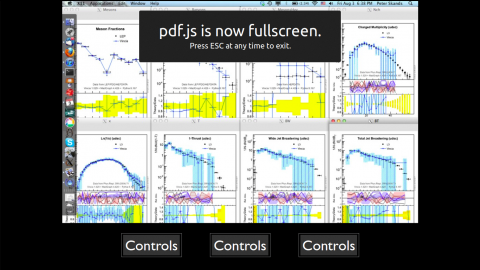
Kickoff
The conceptual sketch of the game components presented at the kickoff is here.
Example
In 2010, a 14-year old summer intern, M. Jeppsson, used a runtime display and the emacs editor to tune the VINCIA plug-in to the PYTHIA high-energy physics event generator to data from experiments performed at the LEP accelerator. His contribution was acknowledged in this scientific paper (on pages 51 and 57. The parameter values he settled on are listed in Appendix B of the paper). Here is a list of what he was looking at, and what parameters he was modifying. Of course, he had a physicist sitting next to him the whole week to explain everything, but if some nice explanations or graphical material could be compiled eg from wikipedia and other sources, in consultation with physicists, then that would already be a nice start.
Accelerator
- The Large Electron Positron Collider (LEP1)
- Beams: electrons and positrons
- Total Collision Energy: 91.2 GeV (which is the mass of the Z boson. Note: each beam had half of that energy)
- Process Studied: hadronic decays of the Z boson
Experiments
- The ALEPH, L3, DELPHI, and OPAL experiments
Data Sets
- Production rates of individual meson types: pi, rho, K, K*, omega, phi, eta, eta'.
- Production rates of individual baryon types: protons, Lambda hyperons, Delta, Sigma, Xi, Xi*, and Omega baryons.
- The probability distribution of the number of charged particles produced (called the charged multiplicity distribution), as measured by the L3 experiment.
- The momentum spectrum of the produced particles, as measured by the L3 experiment.
- The Thrust event-shape variables, as measured by L3.
- The C and D event-shape variables, as measured by L3.
- Jet resolution measurements performed by the ALEPH experiment.
Some plots of the resulting distributions can be found in the physics paper mentioned above. More plots can be found on the mcplots web site, under Beams:ee, Vincia.
Theory / Simulation Parameters
The value of the coupling constant of the strong nuclear force (i.e., Quantum Chromodynamics) at the Z boson mass scale
! * Tuned value of the strong coupling constant
Vincia:alphaSValue = 0.138
Energy scale at which the simulation performs hadronization, i.e., replaces quarks and gluons by hadrons.
! * Shower cutoff scale, in GeV
Vincia:cutoffScale = 0.9
Parameters of the model used for hadronization, called the Lund string model (based on classical strings and quantum mechanical tunneling):
! * String fragmentation parameters
StringZ:aLund = 0.38 ! Suppression factor for hard (high-energy) hadrons
StringZ:bLund = 0.62 ! Suppression factor for soft (low-energy) hadrons
StringPT:sigma = 0.26 ! Transverse momentum kick from string breaking, in GeV
! * String breakup flavor parameters
StringFlav:probStoUD = 0.21 ! Strange quark probability
StringFlav:mesonUDvector = 0.35 ! Spin-1 (vector) meson probability
StringFlav:mesonSvector = 0.55 ! Spin-1 (vector) meson probability for strange mesons
StringFlav:probQQtoQ = 0.08 ! Baryon formation probability
StringFlav:probSQtoQQ = 1.00 ! Strange baryon (hyperon) formation probability
StringFlav:probQQ1toQQ0 = 0.03 ! Spin-1 (vector) diquark probability
StringFlav:etaSup = 0.60 ! Suppression factor for eta mesons
StringFlav:etaPrimeSup = 0.10 ! Suppression factor for eta' mesons
-
-
-
Prerequisites:
-
